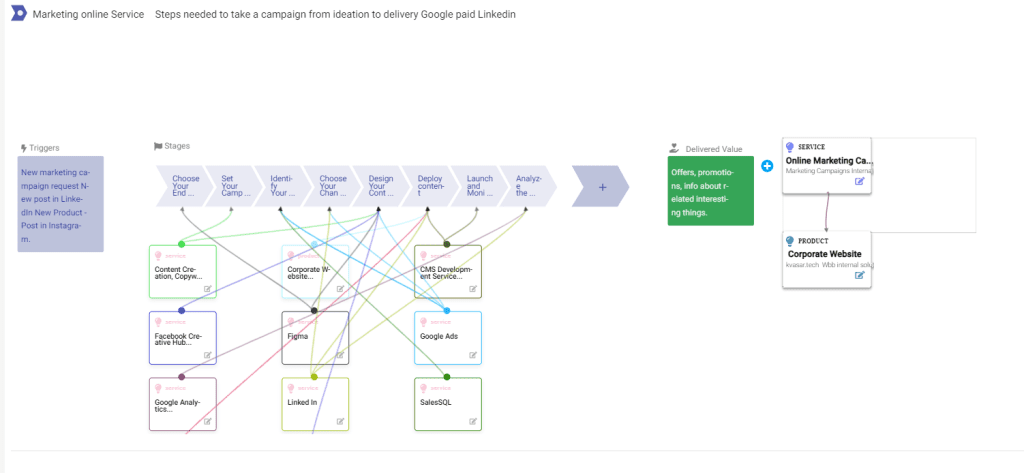Value stream mapping (VSM) is a lean management tool that enables businesses to visualize and analyze their processes in order to identify opportunities for improvement. While it is most commonly used in manufacturing and supply chain management, it can also be a valuable tool for marketing teams. Here are some potential advantages of using VSM in marketing:
- Identifying waste: VSM can help you identify areas where your marketing process may be wasting time, resources, or money. By mapping out your current process and analyzing it step by step, you can identify bottlenecks, redundancies, and inefficiencies that are hindering your marketing efforts. Once you have identified these areas, you can work to streamline or eliminate them, reducing waste and improving your overall efficiency.
- Improving lead time: VSM can help you identify ways to improve your lead time, or the time it takes to move a customer from initial contact to purchase. By analyzing your process and identifying bottlenecks, you can make changes to speed up the process and reduce the time it takes to convert leads into customers.
- Enhancing customer experience: VSM can help you identify areas where you can improve the customer experience. By mapping out the customer journey and analyzing each touchpoint, you can identify areas where customers may be experiencing friction or frustration. By addressing these issues, you can improve the overall customer experience and increase customer satisfaction.
- Increasing agility: VSM can help you be more agile and responsive to changes in the market. By regularly reviewing your process and looking for ways to improve it, you can quickly adapt to changes in customer needs or market trends. This can help you stay ahead of the competition and ensure that you are meeting the needs of your customers.
- Facilitating collaboration: VSM can help you facilitate collaboration between different teams and stakeholders involved in the marketing process. By mapping out the entire process and involving all relevant parties, you can ensure that everyone is on the same page and working towards the same goals. This can help you avoid silos and improve communication, leading to more effective marketing campaigns.

Here are some ideas on how you can apply value stream mapping to marketing:
-
- Customer Journey Mapping: Create a value stream map that outlines the entire customer journey, from awareness to purchase and post-purchase stages. Identify touchpoints, channels, and interactions to understand where value is being created or lost. This can help optimize customer experience and streamline marketing efforts.
-
- Lead Generation and Conversion: Map the process of generating leads and converting them into customers. Identify bottlenecks, delays, and inefficiencies that hinder the smooth flow of leads through the funnel. This can help optimize lead nurturing strategies and increase conversion rates.
-
- Content Creation and Distribution: Analyze the process of creating, approving, and distributing marketing content. Identify delays in content creation, approval cycles, and content delivery. Streamline this process to ensure timely and consistent content production.
-
- Campaign Planning and Execution: Visualize the steps involved in planning and executing marketing campaigns. This includes defining goals, targeting, messaging, creative development, and tracking. Identify areas where communication breakdowns occur or where unnecessary steps can be eliminated.
-
- Data Analytics and Reporting: Map the process of collecting, analyzing, and reporting marketing data. Identify data sources, data transformation steps, and reporting cycles. Streamline data collection processes and ensure that insights are delivered to the right stakeholders in a timely manner.
-
- Social Media Management: Analyze the workflow for managing social media channels. Identify content creation, scheduling, posting, engagement, and analytics. Optimize the process to ensure consistent and engaging social media presence.
-
- Email Marketing: Map the steps involved in email marketing, from designing templates to segmenting lists, sending emails, and analyzing results. Identify areas where personalization and automation can enhance efficiency and engagement.
-
- Event and Trade Show Participation: Visualize the process of participating in events and trade shows. Identify planning, logistics, promotional activities, lead capture, and post-event follow-up. Streamline the process to maximize ROI from event participation.
-
- Market Research and Competitor Analysis: Map the process of conducting market research and analyzing competitors. Identify sources of information, analysis methods, and decision-making steps. This can help in making informed marketing strategies.
-
- Product Launches: Analyze the process of launching new products or services. Identify marketing activities such as market research, positioning, messaging, and promotional tactics. Ensure a smooth launch process by addressing potential bottlenecks.
-
- Feedback and Continuous Improvement: Use value stream mapping to establish a continuous improvement cycle for your marketing processes. Regularly revisit your maps, identify areas for improvement, and implement changes to optimize your marketing efforts over time.
Discover how KVASAR helps your organisation easily and quickly map value streams in a collaborative way for Marketing strategy.
Create your first Value Stream online with KVASAR Agile Management:
Also:
Agile methodologies applied to construction
Check more:
https://www.pmi.org/learning/library/agile-software-applied-to-construction-9931
